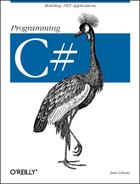Attributes come in two flavors:
intrinsic
and custom
.
Intrinsic attributes are supplied as part of the
Common Language Runtime (CLR), and they are integrated into .NET.
Custom attributes are attributes you create for
your own purposes.
Most programmers will use only intrinsic attributes, though custom attributes can be a powerful tool when combined with reflection, described later in this chapter.
If
you
search through the CLR, you’ll find a great many attributes.
Some attributes are applied to an assembly, others to a class or
interface, and some, such as [WebMethod], to class
members. These are called the attribute targets.
Possible attribute targets are detailed in Table 18-1.
Table 18-1. Possible attribute targets
|
Member Name |
Usage |
|---|---|
|
Applied to any of the following elements: assembly, class, class member, delegate, enum, event, field, interface, method, module, parameter, property, return value, or struct | |
|
Applied to the assembly itself | |
|
Applied to instances of the class | |
|
Applied to classes, structs, enums, constructors, methods, properties, fields, events, delegates, and interfaces | |
|
Applied to a given constructor | |
|
Applied to the delegated method | |
|
Applied to an enumeration | |
|
Applied to an event | |
|
Applied to a field | |
|
Applied to an interface | |
|
Applied to a method | |
|
Applied to a single module | |
|
Applied to a parameter of a method | |
|
Applied to a property (both | |
|
Applied to a return value | |
|
Applied to a struct |
You apply attributes to their targets by placing them in square brackets immediately before the target item. You can combine attributes, either by stacking one on top of another:
[assembly: AssemblyDelaySign(false)]
[assembly: AssemblyKeyFile(".\keyFile.snk")]or by separating the attributes with commas:
[assembly: AssemblyDelaySign(false),
assembly: AssemblyKeyFile(".\keyFile.snk")]Many intrinsic attributes are used for interoperating with COM, as
discussed in detail in Chapter 22. You’ve
already seen use of one attribute ([WebMethod]) in
Chapter 16. You’ll see other attributes, such
as the [Serializable] attribute, used in the
discussion of serialization in Chapter 19.
The System.Runtime namespace offers a number of
intrinsic attributes, including attributes for assemblies (such as
the keyname attribute), for configuration (such as
debug to indicate the debug build), and for
version attributes.
You can organize the intrinsic attributes by how they are used. The principal intrinsic attributes are those used for COM, those used to modify the Interface Definition Language (IDL) file from within a source-code file, attributes used by the ATL Server classes, and attributes used by the Visual C++ compiler.
Perhaps the attribute you are most likely to use in your everyday C#
programming (if you are not interacting with COM) is
[Serializable]. As you’ll see in Chapter 19, all you need to do to ensure that your class
can be serialized to disk or to the Internet is add the
[Serializable] attribute to the class:
[serializable] class MySerializableClass
The attribute tag is put in square brackets immediately before its target—in this case, the class declaration.
The key fact about intrinsic attributes is that you know when you need them; the task will dictate their use.
